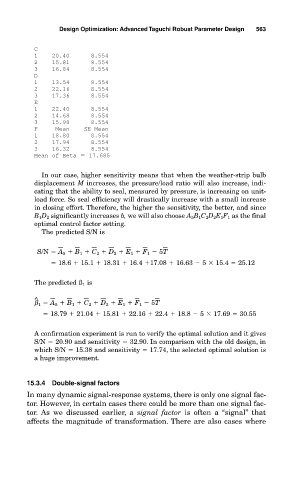Page 609 - Design for Six Sigma a Roadmap for Product Development
P. 609
Design Optimization: Advanced Taguchi Robust Parameter Design 563
C
1 20.40 8.554
2 15.81 8.554
3 16.84 8.554
D
1 13.54 8.554
2 22.16 8.554
3 17.36 8.554
E
1 22.40 8.554
2 14.68 8.554
3 15.98 8.554
F Mean SE Mean
1 18.80 8.554
2 17.94 8.554
3 16.32 8.554
Mean of Beta 17.685
In our case, higher sensitivity means that when the weather-strip bulb
displacement M increases, the pressure/load ratio will also increase, indi-
cating that the ability to seal, measured by pressure, is increasing on unit-
load force. So seal efficiency will drastically increase with a small increase
in closing effort. Therefore, the higher the sensitivity, the better, and since
B 1 D 2 significantly increases b, we will also choose A 5 B 1 C 2 D 2 E 1 F 1 as the final
optimal control factor setting.
The predicted S/N is
S/N A 5 B 1 C 2 D 2 E 1 F 1 5T
18.6 15.1 18.31 16.4 17.08 16.63 5
15.4 25.12
The predicted ß 1 is
^
β 1 A 5 B 1 C 2 D 2 E 1 F 1 5T
18.79 21.04 15.81 22.16 22.4 18.8 5
17.69 30.55
A confirmation experiment is run to verify the optimal solution and it gives
S/N 20.90 and sensitivity 32.90. In comparison with the old design, in
which S/N 15.38 and sensitivity 17.74, the selected optimal solution is
a huge improvement.
15.3.4 Double-signal factors
In many dynamic signal-response systems, there is only one signal fac-
tor. However, in certain cases there could be more than one signal fac-
tor. As we discussed earlier, a signal factor is often a “signal” that
affects the magnitude of transformation. There are also cases where

